Rear seat MERCEDES-BENZ SL500 2002 R129 Owner's Manual
[x] Cancel search | Manufacturer: MERCEDES-BENZ, Model Year: 2002, Model line: SL500, Model: MERCEDES-BENZ SL500 2002 R129Pages: 302, PDF Size: 7.21 MB
Page 23 of 302
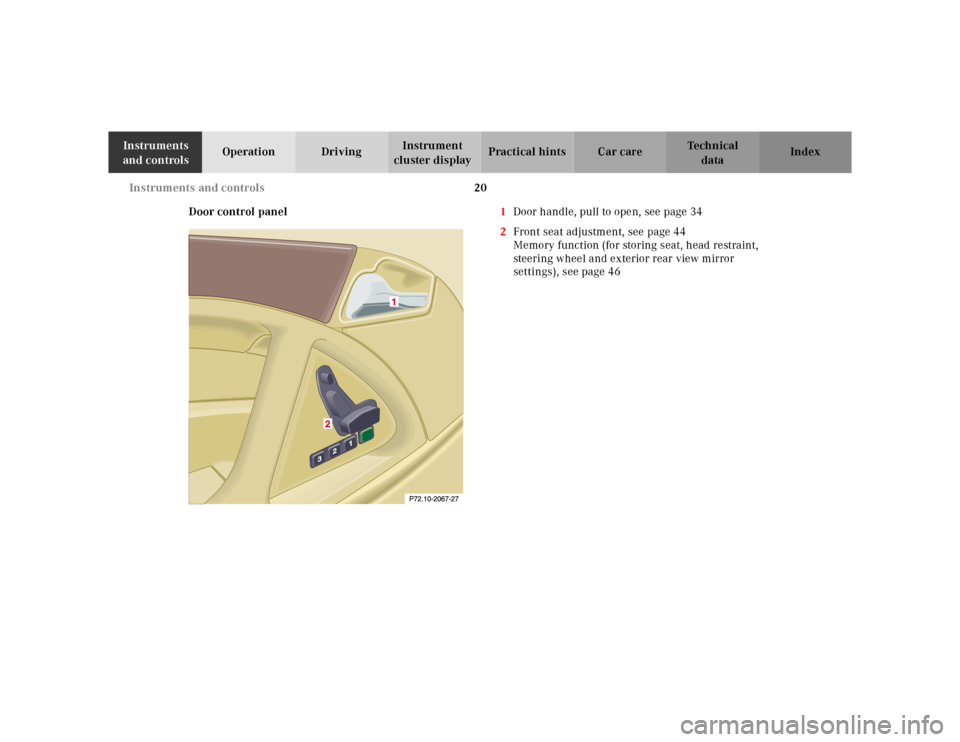
20 Instruments and controls
Te ch n ica l
data Instruments
and controlsOperation DrivingInstrument
cluster displayPractical hints Car care Index
Door control panel1Door handle, pull to open, see page 34
2Front seat adjustment, see page 44
Memory function (for storing seat, head restraint,
steering wheel and exterior rear view mirror
settings), see page 46
Page 30 of 302
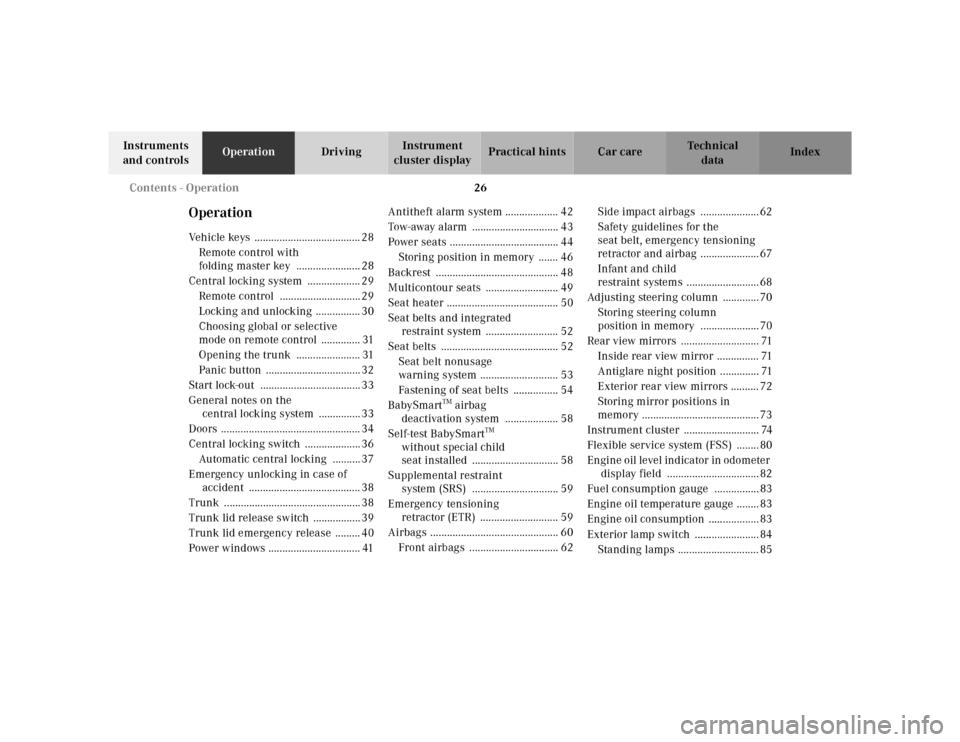
26 Contents - Operation
Te ch n ica l
data Instruments
and controlsOperationDrivingInstrument
cluster displayPractical hints Car care Index
Operation Vehicle keys ...................................... 28
Remote control with
folding master key ....................... 28
Central locking system ................... 29
Remote control ............................. 29
Locking and unlocking ................ 30
Choosing global or selective
mode on remote control .............. 31
Opening the trunk ....................... 31
Panic button .................................. 32
Start lock-out .................................... 33
General notes on the
central locking system ............... 33
Doors .................................................. 34
Central locking switch .................... 36
Automatic central locking .......... 37
Emergency unlocking in case of
accident ........................................ 38
Trunk ................................................. 38
Trunk lid release switch ................. 39
Trunk lid emergency release ......... 40
Power windows ................................. 41Antitheft alarm system ................... 42
Tow-away alarm ............................... 43
Power seats ....................................... 44
Storing position in memory ....... 46
Backrest ............................................ 48
Multicontour seats .......................... 49
Seat heater ........................................ 50
Seat belts and integrated
restraint system .......................... 52
Seat belts .......................................... 52
Seat belt nonusage
warning system ............................ 53
Fastening of seat belts ................ 54
BabySmart
TM airbag
deactivation system ................... 58
Self-test BabySmart
TM
without special child
seat installed ............................... 58
Supplemental restraint
system (SRS) ............................... 59
Emergency tensioning
retractor (ETR) ............................ 59
Airbags .............................................. 60
Front airbags ................................ 62Side impact airbags ..................... 62
Safety guidelines for the
seat belt, emergency tensioning
retractor and airbag ..................... 67
Infant and child
restraint systems .......................... 68
Adjusting steering column ............. 70
Storing steering column
position in memory ..................... 70
Rear view mirrors ............................ 71
Inside rear view mirror ............... 71
Antiglare night position .............. 71
Exterior rear view mirrors .......... 72
Storing mirror positions in
memory .......................................... 73
Instrument cluster ........................... 74
Flexible service system (FSS) ........ 80
Engine oil level indicator in odometer
display field ................................. 82
Fuel consumption gauge ................ 83
Engine oil temperature gauge ........ 83
Engine oil consumption .................. 83
Exterior lamp switch ....................... 84
Standing lamps ............................. 85
Page 48 of 302
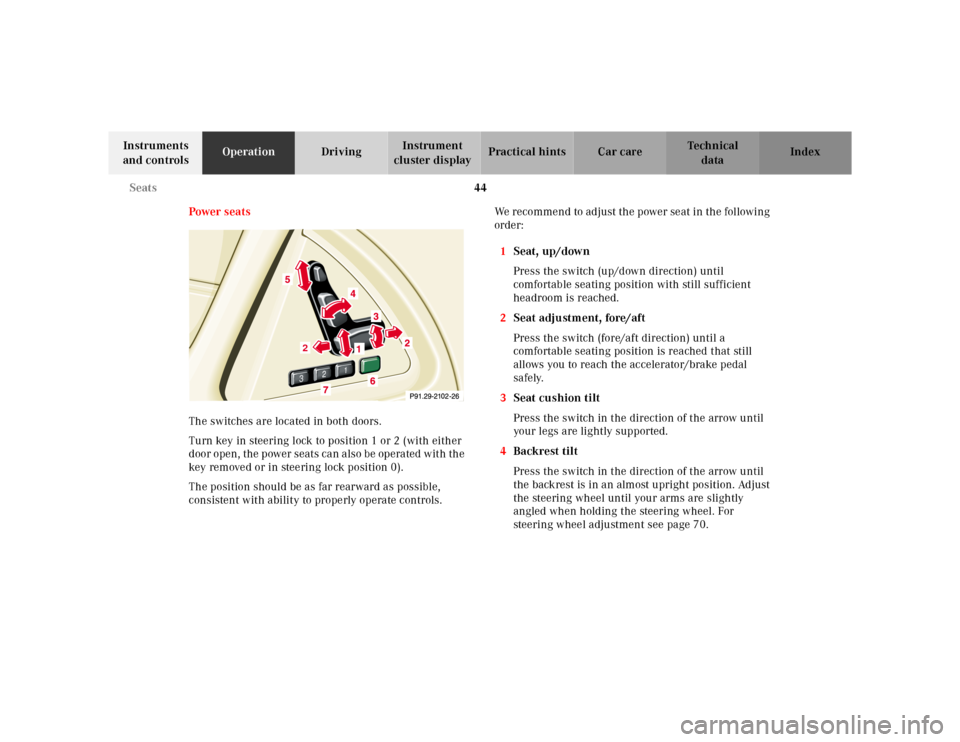
44 Seats
Te ch n ica l
data Instruments
and controlsOperationDrivingInstrument
cluster displayPractical hints Car care Index
Power seats
The switches are located in both doors.
Turn key in steering lock to position 1 or 2 (with either
door open, the power seats can also be operated with the
key removed or in steering lock position 0).
The position should be as far rearward as possible,
consistent with ability to properly operate controls.We recommend to adjust the power seat in the following
order:
1Seat, up/down
Press the switch (up/down direction) until
comfortable seating position with still sufficient
headroom is reached.
2Seat adjustment, fore/aft
Press the switch (fore/aft direction) until a
comfortable seating position is reached that still
allows you to reach the accelerator/brake pedal
safely.
3Seat cushion tilt
Press the switch in the direction of the arrow until
your legs are lightly supported.
4Backrest tilt
Press the switch in the direction of the arrow until
the backrest is in an almost upright position. Adjust
the steering wheel until your arms are slightly
angled when holding the steering wheel. For
steering wheel adjustment see page 70.
3
2
1
2
1
2
Page 49 of 302
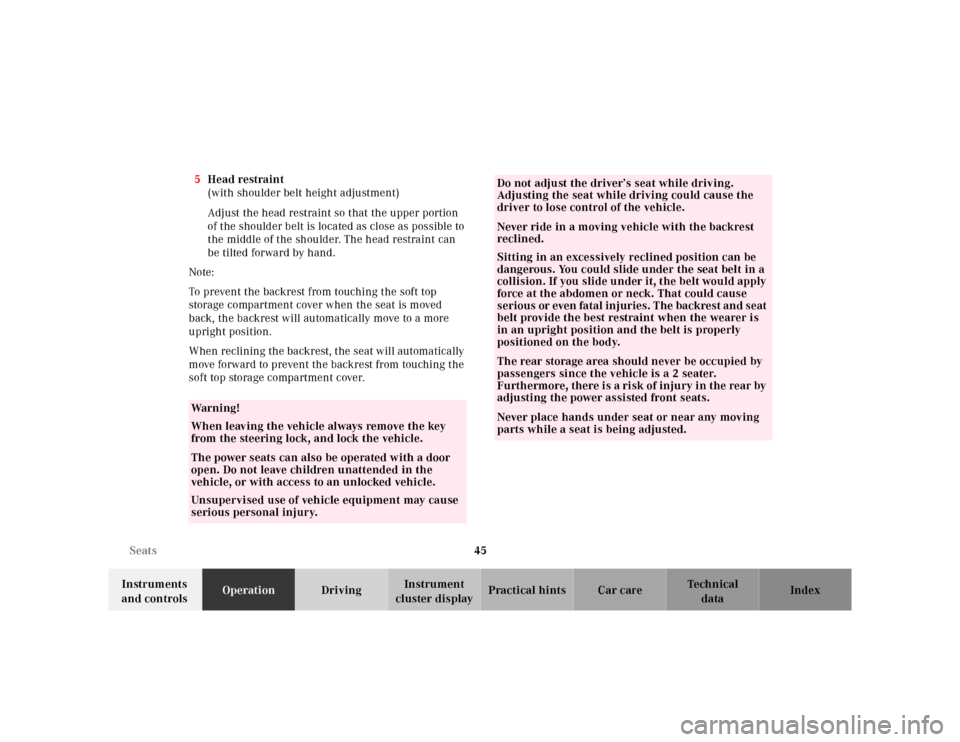
45 Seats
Te ch n ica l
data Instruments
and controlsOperationDrivingInstrument
cluster displayPractical hints Car care Index 5Head restraint
(with shoulder belt height adjustment)
Adjust the head restraint so that the upper portion
of the shoulder belt is located as close as possible to
the middle of the shoulder. The head restraint can
be tilted forward by hand.
Note:
To prevent the backrest from touching the soft top
storage compartment cover when the seat is moved
back, the backrest will automatically move to a more
upright position.
When reclining the backrest, the seat will automatically
move forward to prevent the backrest from touching the
soft top storage compartment cover.
Wa r n i n g !
When leaving the vehicle always remove the key
from the steering lock, and lock the vehicle.The power seats can also be operated with a door
open. Do not leave children unattended in the
vehicle, or with access to an unlocked vehicle.
Unsupervised use of vehicle equipment may cause
serious personal injury.
Do not adjust the driver’s seat while driving.
Adjusting the seat while driving could cause the
driver to lose control of the vehicle.Never ride in a moving vehicle with the backrest
reclined.
Sitting in an excessively reclined position can be
dangerous. You could slide under the seat belt in a
collision. If you slide under it, the belt would apply
force at the abdomen or neck. That could cause
serious or even fatal injuries. The backrest and seat
belt provide the best restraint when the wearer is
in an upright position and the belt is properly
positioned on the body.The rear storage area should never be occupied by
passengers since the vehicle is a 2 seater.
Furthermore, there is a risk of injury in the rear by
adjusting the power assisted front seats.Never place hands under seat or near any moving
parts while a seat is being adjusted.
Page 50 of 302
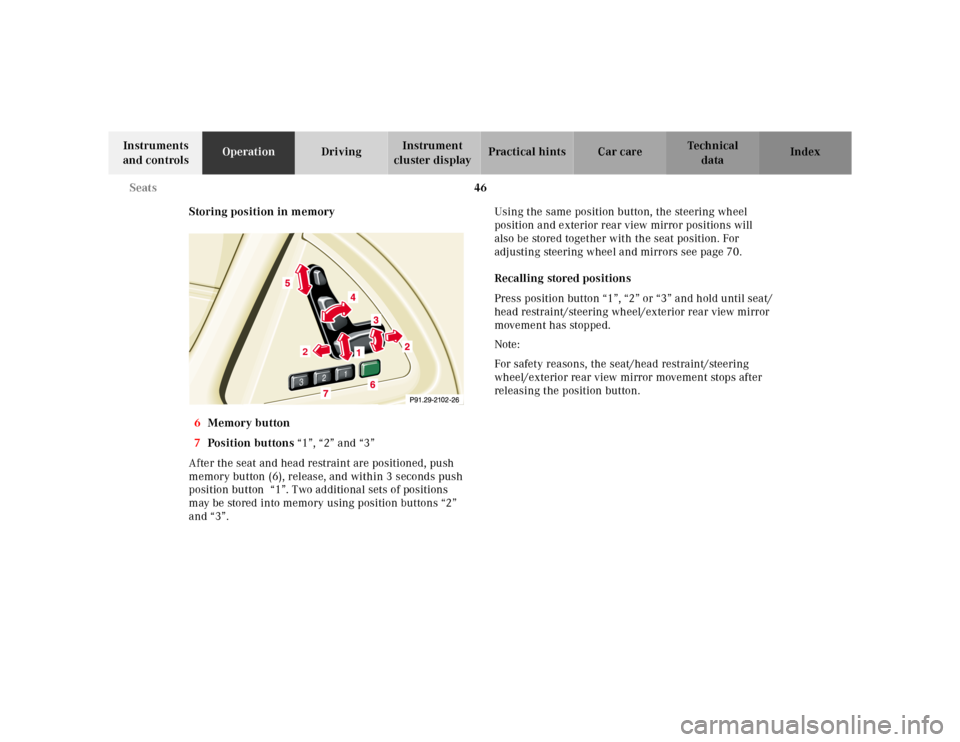
46 Seats
Te ch n ica l
data Instruments
and controlsOperationDrivingInstrument
cluster displayPractical hints Car care Index
Storing position in memory
6Memory button
7Position buttons “1”, “2” and “3”
After the seat and head restraint are positioned, push
memory button (6), release, and within 3 seconds push
position button “1”. Two additional sets of positions
may be stored into memory using position buttons “2”
and “3”.Using the same position button, the steering wheel
position and exterior rear view mirror positions will
also be stored together with the seat position. For
adjusting steering wheel and mirrors see page 70.
Recalling stored positions
Press position button “1”, “2” or “3” and hold until seat/
head restraint/steering wheel/exterior rear view mirror
movement has stopped.
Note:
For safety reasons, the seat/head restraint/steering
wheel/exterior rear view mirror movement stops after
releasing the position button.
3
2
1
2
1
2
Page 51 of 302
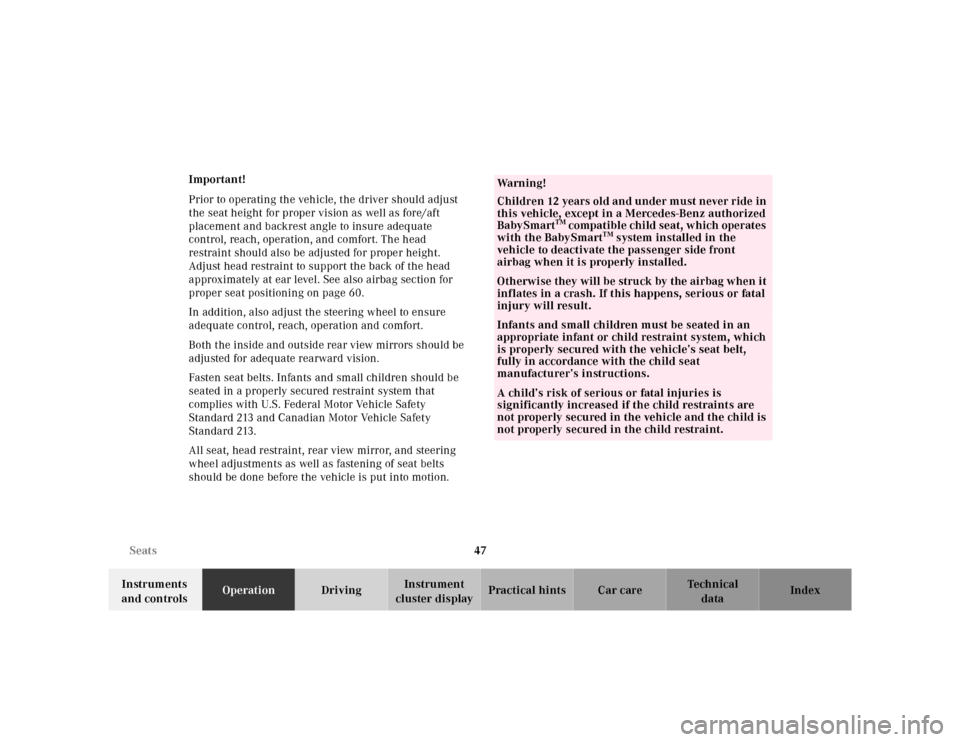
47 Seats
Te ch n ica l
data Instruments
and controlsOperationDrivingInstrument
cluster displayPractical hints Car care Index Important!
Prior to operating the vehicle, the driver should adjust
the seat height for proper vision as well as fore/aft
placement and backrest angle to insure adequate
control, reach, operation, and comfort. The head
restraint should also be adjusted for proper height.
Adjust head restraint to support the back of the head
approximately at ear level. See also airbag section for
proper seat positioning on page 60.
In addition, also adjust the steering wheel to ensure
adequate control, reach, operation and comfort.
Both the inside and outside rear view mirrors should be
adjusted for adequate rearward vision.
Fasten seat belts. Infants and small children should be
seated in a properly secured restraint system that
complies with U.S. Federal Motor Vehicle Safety
Standard 213 and Canadian Motor Vehicle Safety
Standard 213.
All seat, head restraint, rear view mirror, and steering
wheel adjustments as well as fastening of seat belts
should be done before the vehicle is put into motion.
Wa r n i n g !
Children 12 years old and under must never ride in
this vehicle, except in a Mercedes-Benz authorized
BabySmart
TM compatible child seat, which operates
with the BabySmart
TM system installed in the
vehicle to deactivate the passenger side front
airbag when it is properly installed.
Otherwise they will be struck by the airbag when it
inflates in a crash. If this happens, serious or fatal
injury will result.Infants and small children must be seated in an
appropriate infant or child restraint system, which
is properly secured with the vehicle’s seat belt,
fully in accordance with the child seat
manufacturer’s instructions.A child’s risk of serious or fatal injuries is
significantly increased if the child restraints are
not properly secured in the vehicle and the child is
not properly secured in the child restraint.
Page 53 of 302
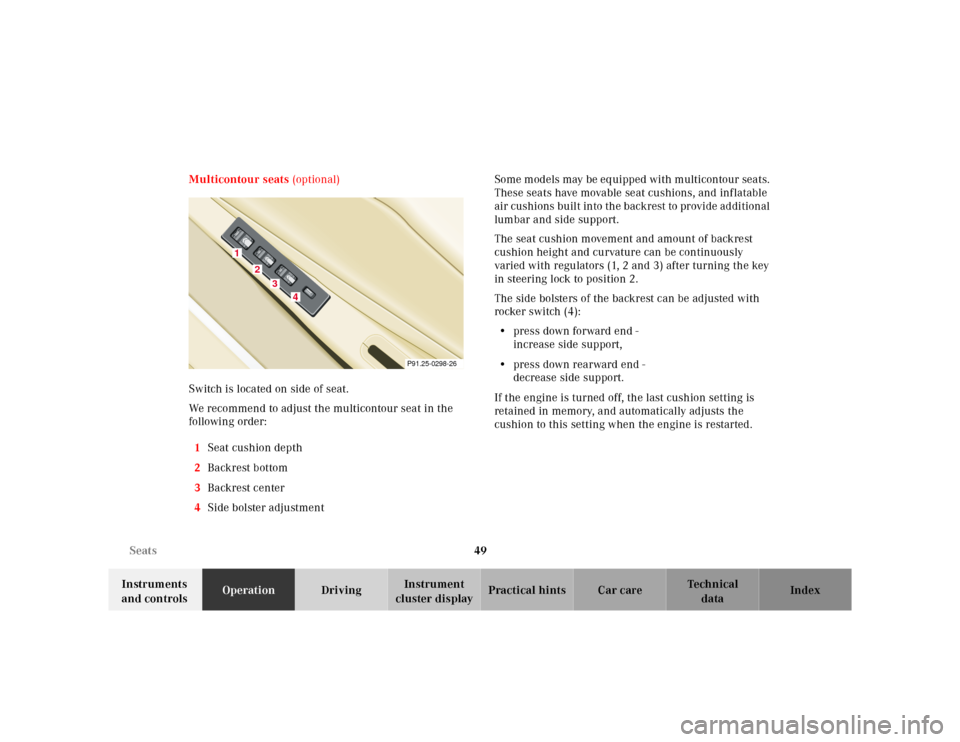
49 Seats
Te ch n ica l
data Instruments
and controlsOperationDrivingInstrument
cluster displayPractical hints Car care Index Multicontour seats (optional)
Switch is located on side of seat.
We recommend to adjust the multicontour seat in the
following order:
1Seat cushion depth
2Backrest bottom
3Backrest center
4Side bolster adjustmentSome m od els may be eq uipped with m ulticontour sea ts.
These seats have movable seat cushions, and inflatable
air cushions built into the backrest to provide additional
lumbar and side support.
The seat cushion movement and amount of backrest
cushion height and curvature can be continuously
varied with regulators (1, 2 and 3) after turning the key
in steering lock to position 2.
The side bolsters of the backrest can be adjusted with
rocker switch (4):
• press down forward end -
increase side support,
• press down rearward end -
decrease side support.
If the engine is turned off, the last cushion setting is
retained in memory, and automatically adjusts the
cushion to this setting when the engine is restarted.
P91.25-0298-26
1
2
3
4
Page 61 of 302
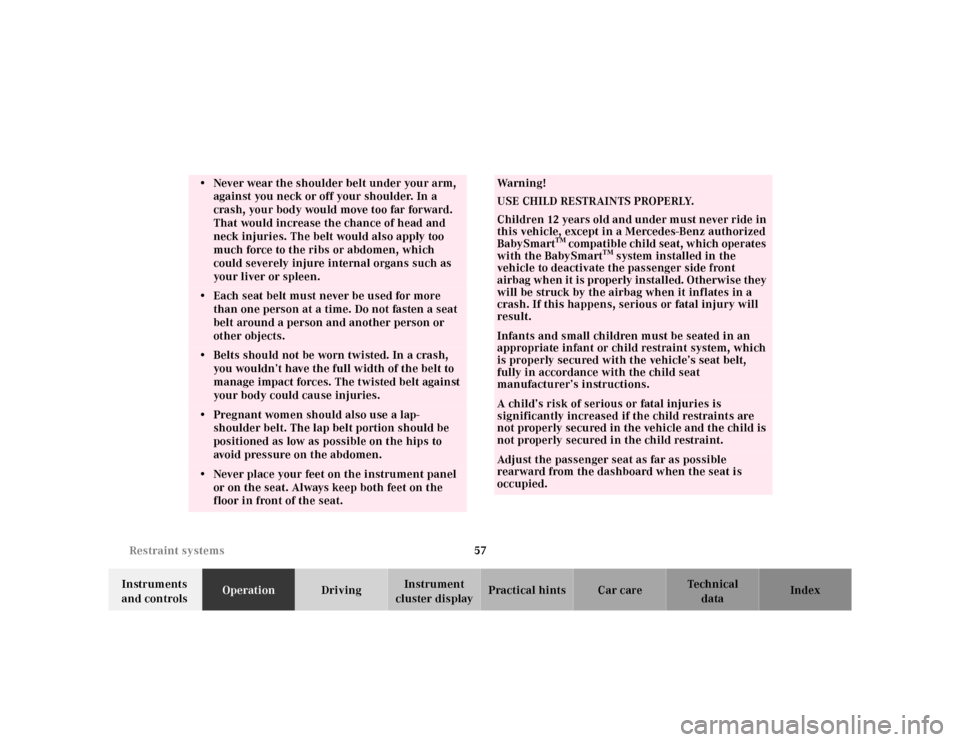
57 Restraint systems
Te ch n ica l
data Instruments
and controlsOperationDrivingInstrument
cluster displayPractical hints Car care Index
• Never wear the shoulder belt under your arm,
against you neck or off your shoulder. In a
crash, your body would move too far forward.
That would increase the chance of head and
neck injuries. The belt would also apply too
much force to the ribs or abdomen, which
could severely injure internal organs such as
your liver or spleen.• Each seat belt must never be used for more
than one person at a time. Do not fasten a seat
belt around a person and another person or
other objects.• Belts should not be worn twisted. In a crash,
you wouldn’t have the full width of the belt to
manage impact forces. The twisted belt against
your body could cause injuries.• Pregnant women should also use a lap-
shoulder belt. The lap belt portion should be
positioned as low as possible on the hips to
avoid pressure on the abdomen.• Never place your feet on the instrument panel
or on the seat. Always keep both feet on the
floor in front of the seat.
Wa r n i n g !
USE CHILD RESTRAINTS PROPERLY.
Children 12 years old and under must never ride in
this vehicle, except in a Mercedes-Benz authorized
BabySmart
TM compatible child seat, which operates
with the BabySmart
TM system installed in the
vehicle to deactivate the passenger side front
airbag when it is properly installed. Otherwise they
will be struck by the airbag when it inflates in a
crash. If this happens, serious or fatal injury will
result.
Infants and small children must be seated in an
appropriate infant or child restraint system, which
is properly secured with the vehicle’s seat belt,
fully in accordance with the child seat
manufacturer’s instructions.A child’s risk of serious or fatal injuries is
significantly increased if the child restraints are
not properly secured in the vehicle and the child is
not properly secured in the child restraint.Adjust the passenger seat as far as possible
rearward from the dashboard when the seat is
occupied.
Page 63 of 302
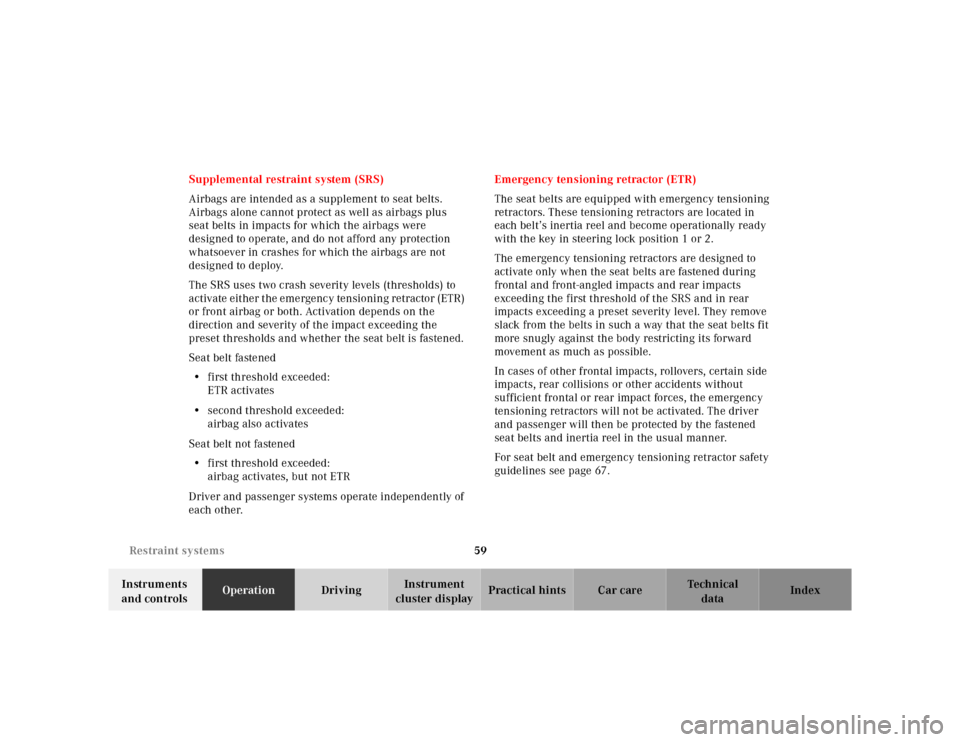
59 Restraint systems
Te ch n ica l
data Instruments
and controlsOperationDrivingInstrument
cluster displayPractical hints Car care Index Supplemental restraint system (SRS)
Airbags are intended as a supplement to seat belts.
Airbags alone cannot protect as well as airbags plus
seat belts in impacts for which the airbags were
designed to operate, and do not afford any protection
whatsoever in crashes for which the airbags are not
designed to deploy.
The SRS uses two crash severity levels (thresholds) to
activate either the emergency tensioning retractor (ETR)
or front airbag or both. Activation depends on the
direction and severity of the impact exceeding the
preset thresholds and whether the seat belt is fastened.
Seat belt fastened
• first threshold exceeded:
ETR activates
• second threshold exceeded:
airbag also activates
Seat belt not fastened
• first threshold exceeded:
airbag activates, but not ETR
Driver and passenger systems operate independently of
each other.Emergency tensioning retractor (ETR)
The seat belts are equipped with emergency tensioning
retractors. These tensioning retractors are located in
each belt’s inertia reel and become operationally ready
with the key in steering lock position 1 or 2.
The emergency tensioning retractors are designed to
activate only when the seat belts are fastened during
frontal and front-angled impacts and rear impacts
exceeding the first threshold of the SRS and in rear
impacts exceeding a preset severity level. They remove
slack from the belts in such a way that the seat belts fit
more snugly against the body restricting its forward
movement as much as possible.
In cases of other frontal impacts, rollovers, certain side
impacts, rear collisions or other accidents without
sufficient frontal or rear impact forces, the emergency
tensioning retractors will not be activated. The driver
and passenger will then be protected by the fastened
seat belts and inertia reel in the usual manner.
For seat belt and emergency tensioning retractor safety
guidelines see page 67.
Page 67 of 302
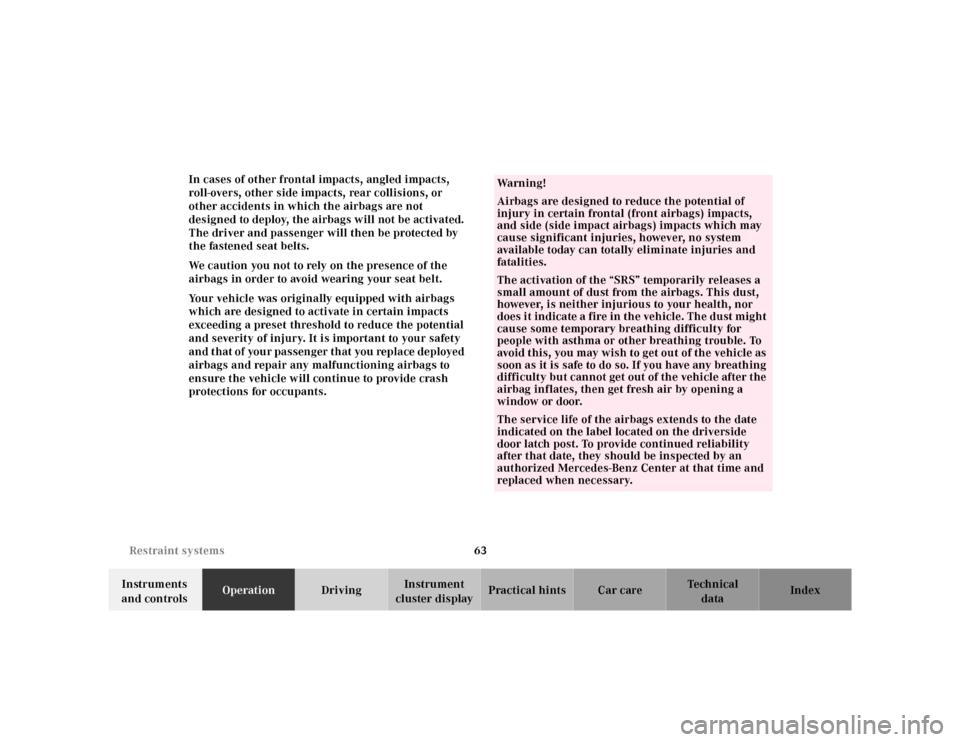
63 Restraint systems
Te ch n ica l
data Instruments
and controlsOperationDrivingInstrument
cluster displayPractical hints Car care Index In cases of other frontal impacts, angled impacts,
roll-overs, other side impacts, rear collisions, or
other accidents in which the airbags are not
designed to deploy, the airbags will not be activated.
The driver and passenger will then be protected by
the fastened seat belts.
We caution you not to rely on the presence of the
airbags in order to avoid wearing your seat belt.
Your vehicle was originally equipped with airbags
which are designed to activate in certain impacts
exceeding a preset threshold to reduce the potential
and severity of injury. It is important to your safety
and that of your passenger that you replace deployed
airbags and repair any malfunctioning airbags to
ensure the vehicle will continue to provide crash
protections for occupants.
Wa r n i n g !
Airbags are designed to reduce the potential of
injury in certain frontal (front airbags) impacts,
and side (side impact airbags) impacts which may
cause significant injuries, however, no system
available today can totally eliminate injuries and
fatalities.
The activation of the “SRS” temporarily releases a
small amount of dust from the airbags. This dust,
however, is neither injurious to your health, nor
does it indicate a fire in the vehicle. The dust might
cause some temporary breathing difficulty for
people with asthma or other breathing trouble. To
avoid this, you may wish to get out of the vehicle as
soon as it is safe to do so. If you have any breathing
difficulty but cannot get out of the vehicle after the
airbag inflates, then get fresh air by opening a
window or door.
The service life of the airbags extends to the date
indicated on the label located on the driverside
door latch post. To provide continued reliability
after that date, they should be inspected by an
authorized Mercedes-Benz Center at that time and
replaced when necessary.